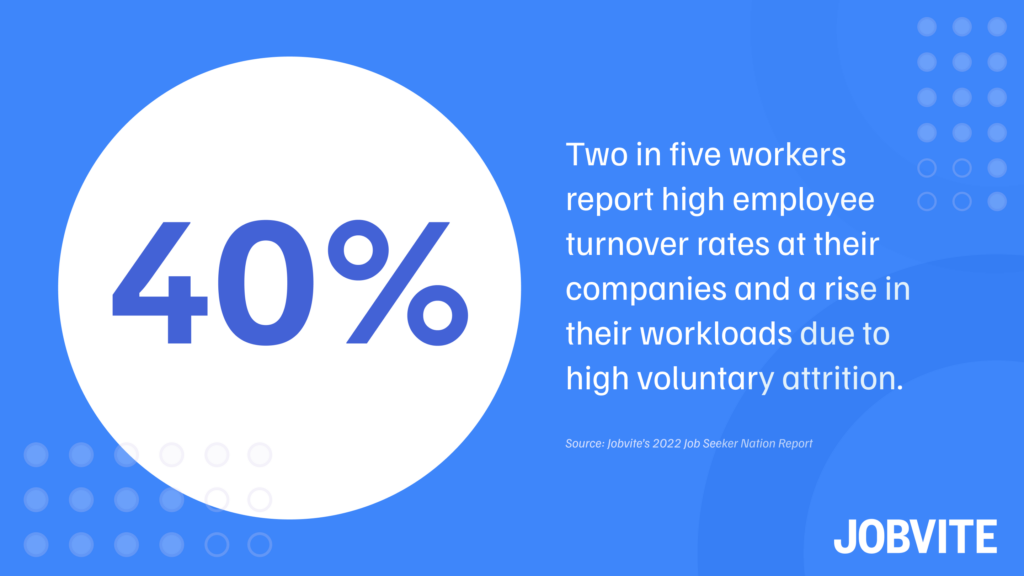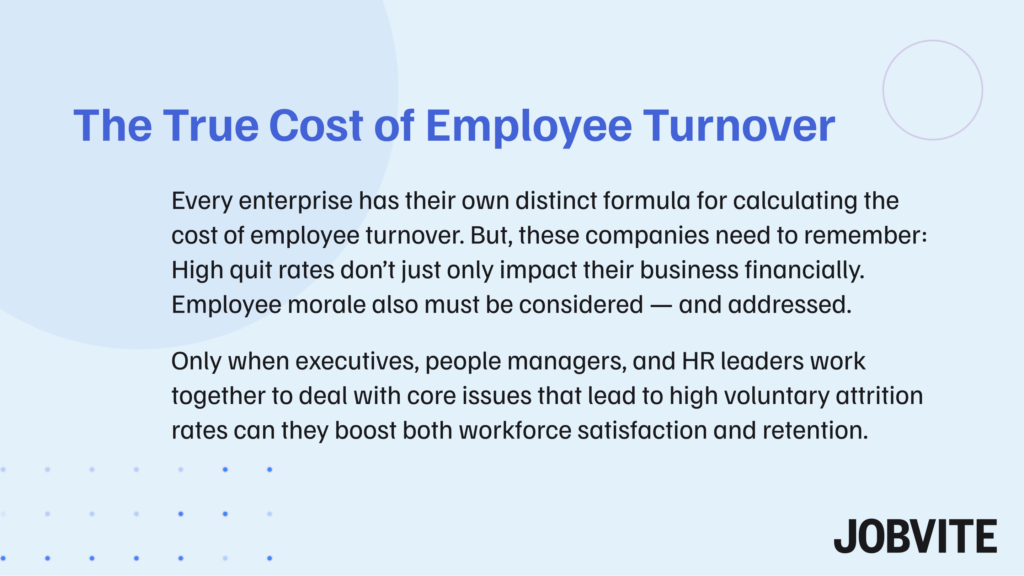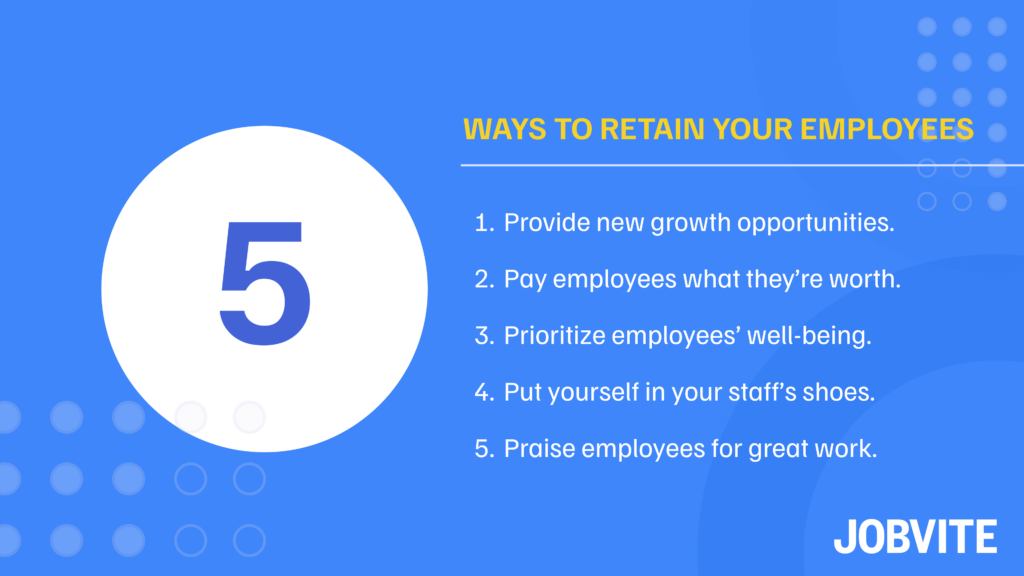Many enterprises calculate employee turnover in the same way. Typically, it is the number of employees who left divided by the average number of employees, multiplied by 100.
However, not every large-scale organization uses the same strategies to reduce their annual turnover rate, boost workforce retention, and replace high-performing employees who left their business.
The key to lowering your employee turnover rate is twofold:
- Your human resources team must dig into its HR data set to learn why previous employees resigned and uncover which roles, teams, and locations see the highest and lowest voluntary attrition.
- These insights must then be shared with your C-suite and managers across the business who have seen employees leave at a high rate to address likely causes of turnover.
Regardless of the exact reasons behind your company’s turnover rate, your HR and talent teams must use turnover-related analytics to make data-backed changes to your talent planning strategy.
Only when your leadership knows the average number of employees who exit your organization over a given period and which roles and teams are impacted can they work with your people managers and HR leaders to find and train new employees who can help drive the business forward.

The impact of high employee turnover on enterprises
The main reason your company should prevent employee turnover is simple.
“Retaining current employees typically costs significantly less than recruiting and training new employees and can be accomplished by building a workplace that aligns with workers’ preferences,” HR expert Corey Berkey recently shared with StrategicCHRO360.
Gallup found one in two professionals are willing to walk away from their current jobs and employers today. The reasons vary. Some cited weak pay and benefits. Others said poor managers and culture.
This makes it vital for enterprise executives to learn what improvements company-wide can help them keep employees and realize their growth goals.
Failing to enact changes workers want means large-scale companies are likely to see their employee turnover rate continually rise and workforce productivity and satisfaction decline.
“Although employees are slightly less likely to leave their jobs now than during the Great Resignation, there is and will continue to be an increase in demands from employees,” Payscale CPO Lexi Clarke recently shared with HR Executive. “And employers must directly address and understand what they can do to meet those requests in order to retain their workforce.”
Another issue that can arise for enterprises amid high-turnover periods is having to decide which roles should be backfilled immediately and which ones can wait.
Corey noted executive leaders shouldn’t automatically backfill positions caused by voluntary attrition. That’s because there could more pressing hiring needs elsewhere in the business.
“Stop and evaluate your organization in its current state and ask yourself if a replacement in the same position is the solution,” Corey wrote for Forbes. “Should you hold off and reduce expenses elsewhere? Should you repurpose dollars to hire a role that will have a greater impact? Should you up-level? Down-level? Taking the time to be reflective at each headcount change event is critical.”

How leading companies reduce employee turnover
There are many problems that can arise when attrition swells and retention dwindles. But, there are two key initiatives your enterprise can undertake to lower high turnover rates today and prevent your talent team from having to find lots of qualified candidates to replace employees who left.
1) Closely analyze and act on employee experience insights
Examining your people analytics in your human capital management software can help your HR team and business leaders determine why your employee turnover rate is high. Here are some of the common reasons workers resign today that could help your organization reduce turnover:
- Low levels of employee engagement. Identifying employees who don’t partake in company events and team gatherings or simply don’t connect proactively communicate and collaborate with colleagues can help you discover who may be checked out and likely to quit soon.
- An unwelcoming work environment. “A safe and inclusive work environment is vital for fundamental employee well-being,” HR expert Cara Brennan Allamano wrote for Forbes. If data shows your workplace environment contributes to high turnover, changes are needed.
- An un-inclusive company culture. Do some workers feel like outsiders at your organization, based on recent engagement survey results? Then you likely have culture issues that need to be rectified to ensure all employees have a voice and a sense of belonging at your business.
- Little or no progress with DEI efforts. Programs focused on hiring more individuals from underrepresented groups and ensuring equal pay for equal work impact your workforce’s views on the business — and whether employees want to remain at your company long term.
- Poor work-life balance/high burnout. Stress levels are at an all-time high for many workers — even those in talent acquisition, the 2023 Employ Recruiter Nation Report found. Find ways to make work less burdensome and more enjoyable, and retention will rise.
- Limited training program access. Learning and development empowers employees to work their way into more meaningful and often higher-paying roles. Learn if your job mobility programs are helping workers level-up internally. If they aren’t, your staff may not stick around.
- Unhelpful feedback from managers. Just as your TA team needs a structured interview approach to evaluate candidates effectively, your people managers need a structured feedback approach to help employees grow professionally. See if managers’ feedback is constructive and supports workers in their efforts to advance their careers within the organization.
This last focal point plays a pivotal role in helping enterprises drive down employee turnover.
“Ultimately, creating space for open and honest communication with employees will improve their experience and satisfaction at work, ideally preventing them from leaving your organization,” Progyny Sr. VP of People Cassandra Pratt recently shared with SHRM. “Managers who demonstrate genuine care and investment are more likely to have employees who do the same.”

2) Examine your hiring team’s recruiting insights and overall approach
Your HR analytics aids with workforce assessment. Meanwhile, your talent acquisition data is another valuable resource that can provide insights into the causes of your high employee turnover.
Jobvite offers built-in recruitment analytics that enables all hiring stakeholders — not just TA leaders and specialists, but also hiring managers and operations managers — to quickly and easily evaluate data tied to their daily recruiting activities.
Syncing Jobvite with UKG, ADP, and other human resources information systems helps talent teams easily transfer data for new hires stored in Jobvite’s recruitment software directly to the HRIS.
This leads to the creation of a new employee record, where HR can track employees’ output and contributions to the business over time, based mostly on performance review data.
This ability for HR to efficiently track employees’ productivity means they can create custom reports for their executive team, people managers, and talent leaders that feature quality-of-hire data.
These reports can shed light on how much value both employees who remain at and left your business provide. From here, you can pinpoint patterns that can be shared with other hiring decision-makers.
Here is what these reports often tell enterprise leaders at a high level:
- Workers who quit and were deemed highly productive likely left your organization due to circumstances separate from their daily work.
- Employees who resigned and were labeled as not very productive likely left your business because they weren’t strong fits for the roles in question.
Those who fall into the first bucket were worth hiring, given their expertise helped them contribute to their team and overall business goals. Exit-interview data for these folks can be used to learn what fixes at your company could have changed their mind and made them stay.
As for employees with low quality-of-hire scores, you can cross-reference these former staff members with your TA team’s profiles for them to learn how they were added to their talent pool (applied or sourced) and revisit their answers during each interview. These insights can ultimately inform changes to how recruiters and hiring managers evaluate potential hires.
Speaking of TA, regular reviews of sourcing, nurturing, and interviewing data can help you discover the types of job seekers they typically engage and advance.
Here are some questions you can ask your recruiters, including sourcers, that can help your organization determine your work’s possible impact on employee turnover:
- Do job descriptions feature inclusive language and clearly relay expectations of eventual hires?
- Are postings published and promoted in places where your ICP typically looks for new work?
- What kinds of questions do sourcers ask in pre-screening questionnaires and/or screen calls?
- Are interviews highly structured with standard questions, or are they looser in format?
- Does each interview panelist take thorough notes during interviews with potential candidates?
- Is candidate feedback compiled and discussed shortly after each interview is conducted?
- Do hiring managers ensure candidates who advance in the funnel match role-based needs?
It is through this quantitative and qualitative analysis of your recruiting tactics and techniques with purpose-built recruitment technology that can lead to greater retention and lower turnover.

Using recruitment software to address high employee turnover and adjust your talent planning
Just remember that, as you regularly review your employee turnover and recruiting data, it’s vital to ensure you have a robust candidate pool ready to engage for roles you need to backfill.
“Having that bench of talent ready to come in and take your open positions can help you reduce your time to fill while also strengthening your employer brand,” Corey shared with Zenefits.
That’s where a purpose-built, enterprise talent acquisition solution can help your business.
Discover the power of Jobvite’s enterprise applicant tracking software today. Check out our product tour video or schedule a custom demo with our team today for more information.





